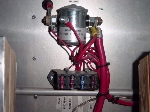


Using a Master Relay
By: Jim Hayward
For those using an electric starter, a Master Relay is suggested to isolate the battery from the (heavy current capacity) #4 wire connecting the battery to the Starter Relay. This would be recommended if your starter solenoid is more than a couple feet away from the battery, like a nose mounted battery. It's a safety consideration that, in the event of a crash, the Master Switch will be turned off, cutting electrical power to the aircraft, so if any broken or frayed wires occur, they will not be energized and possibly start a fire from sparks. The addition of a Master Relay to an existing system is easy in that the #4 wire from the battery to the Starter Relay is simply cut wherever the Master Relay is to be mounted. Those two wire ends are then connected to the Master Relay's contactor terminals and smaller wire run from the Master Relay coil terminals to the Master Switch on the instrument panel. The Master Relay is a continuous duty, 12 volt relay which is also called a solenoid. It may be purchased from sources such as Wicks Aircraft and Aircraft Spruce & Speciality for less than $20. The Master Relay should be mounted as physically close to the battery as is practical in order to minimize the length of electrically hot wiring from the battery to the aircraft's 12 volt buss and starting system. While a Master Switch by itself on the instrument panel can cut electrical power to the aircraft's 12 volt buss, it can not interrupt power to the starter circuit which is capable of carrying hundreds of amps of current and is not fused. Therefore, some sort of isolation is desired hence, the Master Relay. So, when the Master Switch on the instrument panel is turned on, it will energize the Master Relay which will not only supply power to the 12 volt buss, but to the starting circuit as well. Connection is quite simple as can be seen in the diagram. The #4 gauge wire that normally would go from the battery to the Starter Relay will now be a short piece of #4 wire connecting the battery's positive terminal to one of the contactor posts on the Master Relay. The other contactor will connect to the Starter Relay also with #4 wire. A smaller gauge wire (such as 18 gauge) will connect from the terminal going to the Starter Relay to the +12 volt aircraft buss. Another similar wire will connect from the terminal to the battery to the Master Switch's BATT terminal. One of the coil posts on the Master Relay will be grounded and the other will connect to the Master Switch's ON or IGN terminal. The wire to the Master Relay coil may be fused at 1 to 3 amps. |
 
 |
 |